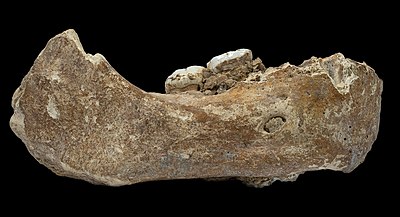Talk:Xiahe mandible
| A news item involving Xiahe mandible was featured on Wikipedia's Main Page in the In the news section on 4 May 2019. |
| This article is rated Start-class on Wikipedia's content assessment scale. It is of interest to the following WikiProjects: | |||||||||||||||||||||||||||||||||||||||||||||||||||
| |||||||||||||||||||||||||||||||||||||||||||||||||||
Common error
[edit]Just because something is "found" at a location does not always mean that that something lived there. It could be the result of being tossed away while passing through.
In this case, there's nothing in the article that proves that the hominid actually lived there.
It's just as plausible that the hominid was part of a migrating band just passing through and was severely injured while hunting. The band may have stayed long enough to determine if the injured party would recover or even continue to travel. If not, the band could've moved on, leaving the injured party some food. Or, the band moved on, but one or two could've stayed until the injured party passed away. Any of these scenarios could account for what was mentioned in this article as being found in the cave. (Remember, I'm only going by what is stated in the article.)
So, for the intro paragraph to boldly state that the fossils prove adaptation and high altitude living without any inline citation is, in my opinion, not right.
Or, am I missing something? 2600:8800:784:8F00:C23F:D5FF:FEC4:D51D (talk) 18:17, 4 May 2019 (UTC)
- You're indeed missing a lot. The article clearly states that numerous stone tools and animal bones with cut marks are found in the cave, a clear sign of habitation. For detailed scientific evidence and methods, you need to read the Nature paper, not Wikipedia. And per WP:LEAD, the intro does not have citations for information cited in the article body, which is cited to the Science article wrt high-altitude adaptation. -Zanhe (talk) 20:49, 4 May 2019 (UTC)
Featured picture scheduled for POTD
[edit]Hello! This is to let editors know that File:Xiahe mandible.jpg, a featured picture used in this article, has been selected as the English Wikipedia's picture of the day (POTD) for May 29, 2022. A preview of the POTD is displayed below and can be edited at Template:POTD/2022-05-29. For the greater benefit of readers, any potential improvements or maintenance that could benefit the quality of this article should be done before its scheduled appearance on the Main Page. If you have any concerns, please place a message at Wikipedia talk:Picture of the day. Thank you! Cwmhiraeth (talk) 10:49, 21 May 2022 (UTC)

|
The Xiahe mandible is a hominin fossil jaw discovered in Baishiya Karst Cave, on the northeastern edge of the Tibetan Plateau in Xiahe County, Gansu, China. It was found in 1980 by a Buddhist monk who had entered the cave to meditate. This fossil discovery demonstrated that archaic hominins were present in a high-altitude, low-oxygen environment by around 160,000 years ago. Discover, Science News and Nova all named the discovery of the mandible in their lists of top science stories of 2019. Photograph credit: Dongju Zhang
Recently featured:
|
- Wikipedia In the news articles
- Start-Class China-related articles
- Mid-importance China-related articles
- Start-Class China-related articles of Mid-importance
- WikiProject China articles
- Start-Class Palaeontology articles
- Mid-importance Palaeontology articles
- Start-Class Palaeontology articles of Mid-importance
- WikiProject Palaeontology articles
- Start-Class Anthropology articles
- Low-importance Anthropology articles
- Start-Class Primate articles
- Low-importance Primate articles
- WikiProject Primates articles
- Start-Class Tibet articles
- Mid-importance Tibet articles
- WikiProject Tibet articles




